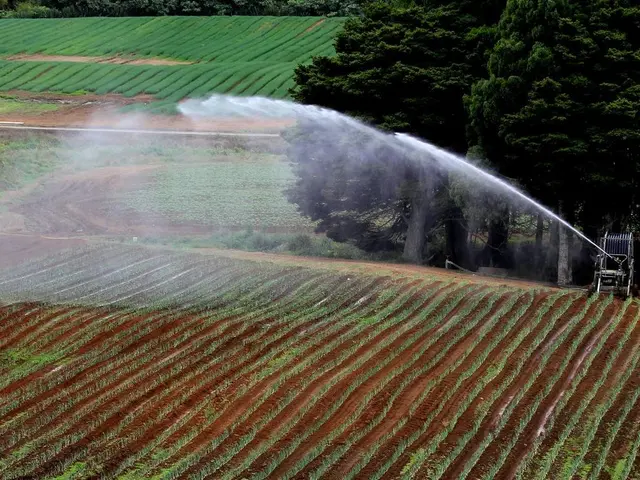Insights on Food: Statistical Data and Analysis
Modern Mealtime Woes: Navigating Food Security and Sustainability in the 21st Century
In the hustle and bustle of today's world, food plays a pivotal role. But it's not just about finding nourishment; the production, trade, and consumption of it has far-reaching implications, affecting cities and the globe at large. To adapt to our rapidly changing world, understanding the complexities of our food systems is essential.
Urban Feeding Frenzy
Over 80% of the food produced worldwide is eaten in urban areas, and with the planet projected to host nearly 10 billion people by 2050, we'll need to boost food production by almost 50% compared to the early 2020s. If we fail to do so, hunger and food insecurity will only worsen. As it stands, the World Health Organization reports that 828 million people suffered from hunger in 2021 – that's 46 million more than in 2019.
Quality matters, too. One-in-three people couldn't access adequate food in 2020, and food insecurity affected nearly 30% of the global population in 2021 – a sharp increase related to the COVID-19 pandemic. For many, the rising costs of living mean shorter grocery lists, with the UK seeing 4 in 10 shoppers buy less due to financial strain. Food prices rose 19.1% in April 2023 (still below the 24% inflation seen in sub-Saharan Africa's hardest-hit countries), but low-income families are less likely to consume fresh fruits, vegetables, and fiber. The presence of food banks has grown in cities over the years, with one-in-seven Americans relying on them for sustenance, and the Trussell Trust reporting a surge in first-time users in the UK due to insufficient income for food and heating costs.
Not all hope is lost, however. In Africa, though food banks are relatively scarce – with only 25 banks across the continent in early 2023 – organizations like Food Banking Kenya redistribute surplus food where it's needed.
A Spoiled Feast
But the issues don't end once the food has been eaten. Waste is a significant challenge. According to the United Nations Environment Programme (UNEP), 931 million tonnes of food went to waste in 2019, accounting for 8-10% of all greenhouse gas emissions. This is partly due to poor habits, as buying more than we can consume and discarding unused food is all too common. The problem doesn't solely lie with consumers, though, as food loss at the harvest and retail stages – often due to the disposal of 'ugly' produce – affects 14% of the world's food supply.
A Green Thumb in the City?
Enter urban agriculture. With increasing populations and an interest in self-sufficiency, cities increasingly turn to local food production as a means to meet their nutritional needs. Urban agriculture may provide between 10% to 20% of the crops we need, but relying solely on city farming would mean a heavy reliance on rural partners for the foreseeable future. Still, growing food locally offers advantages, such as energy savings, improved stormwater management, and nitrogen sequestration – which could benefit the economy by around $33 billion per year.
Exactly how many urban farms there are isn't clear, with estimates ranging from 800 million people practicing urban agriculture to less definitive reports. What's sure is that urban agriculture has the potential to combat food insecurity – particularly in urban areas – and cut down on transportation emissions.
(Meat) Below the Surface
Our diets also have a significant environmental impact. The global food system contributes a staggering 26% of greenhouse gas emissions, with 19% of these emissions coming from transportation within the food system, twice as much as the emissions generated during the production of the food itself. Meat is the largest contributor, releasing 14% of all carbon dioxide generated by human activity.
A shift towards plant-based diets is seen as a step towards more sustainable food systems, with lab-grown meat – also known as cultured meat – being hailed as a more ethical alternative. This meat, grown from stem cells, is developed without the need for livestock, leading to significant reductions in greenhouse gas emissions, land use, and water consumption. Lab-grown meat is currently still in development, but its future potential is promising: it can be developed from animal blood or even from vegetable sources. However, concerns remain around its cost, consumer acceptance, and potential religious implications.
Pesky Pests and Powerful Plants
Another way to reduce our environmental footprint is by embracing insects as a food source. Insects have a high protein content and low environmental impact, requiring up to 10 times less land, feed, and water than traditional livestock production. These critters could play a role in producing food for both humans and livestock, reducing greenhouse gas emissions, and providing a more sustainable and resilient food system.
Eating for Change
As our understanding of the impact of food production on the environment grows, so does consumer awareness. According to a YouGov survey in the UK, 40% of respondents are open to eating meals containing insect-based ingredients, with half a hectare of insect larvae producing more protein than 52 hectares of soybeans. In fact, the insect protein market is predicted to be worth up to $8 billion by 2030. However, to reach mass market adoption, insect-based food products will need to become more affordable, regulations will need to support industry growth, and cultural acceptance will need to shift.
The Future on Our Plates
The future of food production and security is one of innovation and change. Sustainable farming practices, technological advancements, and a growing focus on health and nutrition will all play a role in meeting the demands of a rapidly growing population. Urban agriculture will likely expand, and advanced water-saving technologies will be essential for efficient use in this urban context. The humanization of technology in food production will be crucial for consumer acceptance, and an increased focus on diversified ingredient sourcing will enhance supply chain resilience.
Ultimately, change begins with awareness and a commitment to choices that support our planet and our fellow inhabitants. So, let's embrace sustainable diets, reduce waste, and work towards a greener, cleaner future for food production. And who knows – perhaps insect tacos will become the next big thing.
- Science plays a significant role in understanding and addressing the complexities of our food systems in the 21st century.
- Health-and-wellness is intertwined with food security and sustainability, as the right nourishment is crucial for a healthy population.
- Climate-change and food production have a direct correlation, with the global food system contributing 26% of greenhouse gas emissions.
- Environmental-science plays a key role in addressing food waste, which accounts for 8-10% of all greenhouse gas emissions.
- Finance is essential in boosting food production to meet the needs of a growing population, as the planet is projected to host nearly 10 billion people by 2050.
- Cooking plays a personal role in reducing food waste by encouraging the consumption of unused food and the proper storage of perishable items.
- Lifestyle choices, such as adopting plant-based diets, can contribute to more sustainable food systems and combat food insecurity.
- Fashion-and-beauty industries can support sustainable living by using organic, locally-sourced materials and reducing waste in their production processes.
- Food-and-drink industries must prioritize reducing transportation emissions and food loss at various stages of the supply chain to promote a more sustainable food system.
- Family-dynamics can influence food choices and consumption patterns, making it essential for families to have access to nutritious, affordable food options.
- Investing in agricultural technology and sustainable farming practices can lead to increased food security, reduced greenhouse gas emissions, and higher returns on investment.
- Wealth-management should consider the long-term environmental and social impacts of investments in the food and agriculture sectors.
- Home-and-garden plays a role in reducing food waste by promoting home gardening and composting.
- Business entrepreneurs can innovate in the food industry by creating plant-based products, insect-based food products, or lab-grown meat to meet the demands of a changing food system.
- Personal-finance, data-and-cloud-computing, and technology can be leveraged to optimize food systems, reduce waste, and promote sustainable living through insights and efficiency gains.








